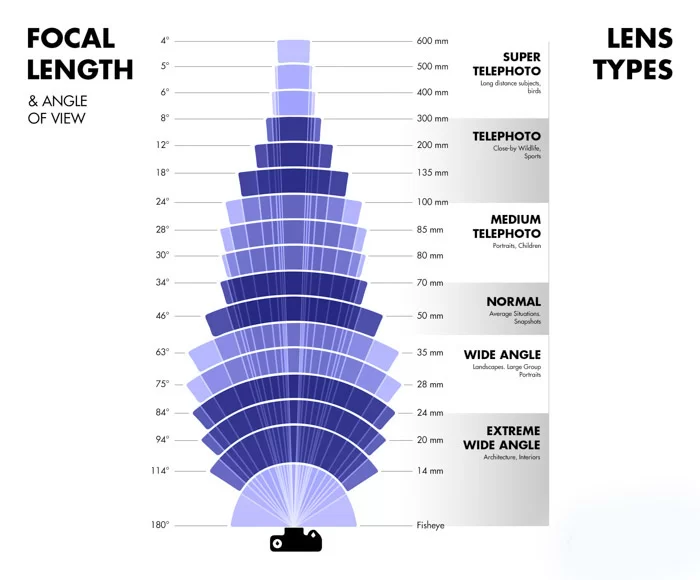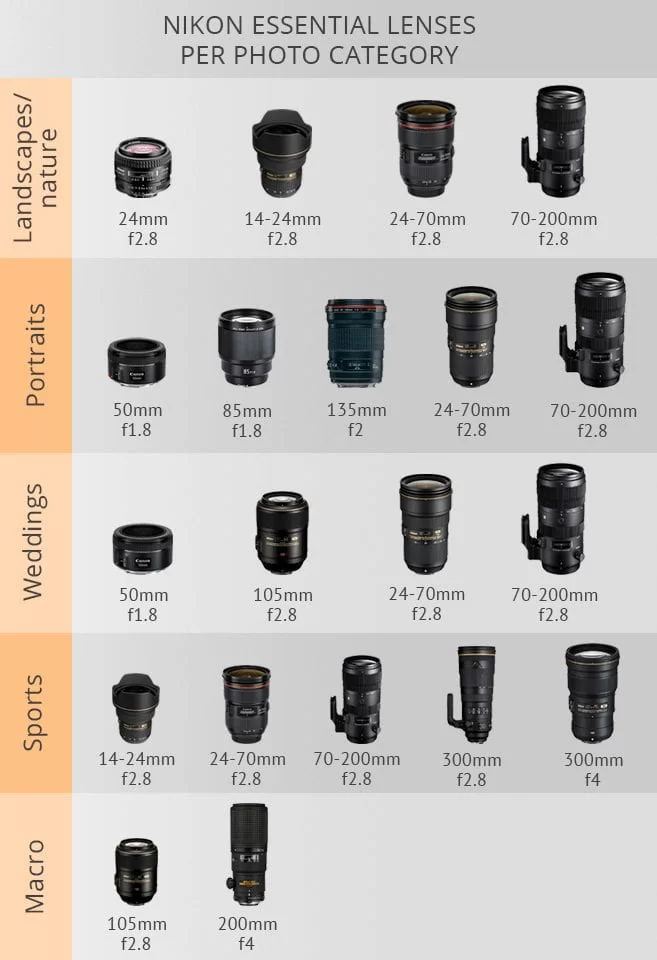The Different Types of Camera Lenses for Video and Photography
The camera is one of the most essential tools to record important moments of our lives. Cameras have been in different shapes and sizes in the past, and each hascharactersatures and characteristics. With the increase and improvement of new technologies, ily take cameras with us wherever we want and use them. One of the most prac parts of any camera we must look at is camels. Camera lenses help us record memorable images and use them to save special moments based on our position and the desired subject. In this article, we wo check what a camera lens is and what its characteristics and types are, their details get to know the details of each of them.
What is a camera lens?
A camera lens is a cylindrical lens with multiple lenses of different sizes that pass light through it and direct it into the camera. The camera lens will make the images we record more transparent and reflect on the photographic film or the receiver of the images. The quality of a photo often depends on the lens used rather than the hardware characteristics of the camera with which we take pictures. The lens of some cameras available at a lower price in the camera market cannot be removed and can be seen assembled.
But some SLR single-lens reflex cameras, Contax single-lens non-reflective cameras, and Mamiya series non-reflective cameras of the double-lens type can be changed, and we can choose alternative and more professional lenses for them. If we observe sports events such as football, we will see sports photographers recording them with their vast lenses. You may ask, what is the use of this type of camera lens? We must say that professional photographers know the difference between different lenses very well and have their lenses for every kind of image and environment in which they are placed.
Camera lenses are professional photographers’ work tools. These lenses cover different focal lengths that can be installed on the camera depending on the type of subject and its conditions. We should know that , when we change the lens in digital cameras, some dust enters the body and sits on its sensitive sensors. This problem can often reduce the quality of recorded photos and images. So, when changing the camera lens, we must carefully observe all the technical aspects and precautions.
Familiarity with focal length
What is meant by focal length? It is the distance between the camera sensor and the focal point of the lens, called the focal length. The focal length measurement unit is in millimeters showing its accuracy is very high because the smaller the measurement unit, the higher the accuracy.
We don’t need to know the concept and characteristics of focal length because every lens is named and known using the same amount of focal length; that is, a 30 mm lens has a focal length of 30 mm. The focal length will show how much our camera lens can capture the landscape and how big will all the objects in our surroundings look in one frame.

Now, the higher the focal length in the lenses, the narrower the angle of view will be, and by working with lenses with a higher focal length, all objects will be larger than what is seen with the naked eye. On the other hand, we should know that the focal length with a smaller angle will give us a more comprehensive view, and because of this, all the components and objects in a frame will be smaller compared to what everyone sees.
Introducing the aperture number in the camera lens
What is meant by the aperture number in the camera lens? It is a unique number placed on the cylindrical part of the lenses, called the lens ratio. The lens ratio indicates the maximum aperture of the lens when the camera is at its highest zoom. Another use that gap has is how much light will be delivered from the lens to the camera sensor. We must remember that the lower the aperture number, the more open the lens will be, and it will perform better in low light and dark situations. In most lenses with high-quality zoom, the opening and opening of the aperture has a constant value during the zoom range.
While in low-quality lenses, with the increase of the focal length, the amount of the coefficient of the aperture number changes. For example, if the camera lens is 100-400mm, the maximum aperture at a focal distance of 400mm equals f/8,, and at a focal length of 100mm, it will be similar to f/3.5. The reason for this difference is that when we zoom from comprehensive to telephoto, at least one step of light is removed, so in general, the lower the f-number of the camera lens, the higher the lens quality.
Checking the strength and quality of camera lenses
The lens’s quality and strength will depend on several factors, one of the most important of which is the aperture number or focal length. The focal length is measured in millimeters and determines the angle of view of the lenses. It would help if you kept in mind that the shorter the focal length of the lens, the wider the angle of view will be, and in other words, we have a wider lens, and in the same way, the higher the aperture number, the smaller and shorter the angle of view.
Some lenses used have a fixed focal length, and others have a variable value. Lenses whose focal length is variable will have higher flexibility,; therefore,, photographers can frame better and more efficiently. But lenses that have a fixed focal length will have better photo quality.
Note: In single-lens film reflex cameras, known as 35 mm cameras, because they have a fixed photographic film size, the relationship between the lens’s angle of view and the focal length will be clear.
But this situation is not valid in digital cameras, and taking into account the sensors’ dimensions, the lens’s angle of view will be affected. Every camera currently in the market, from the famous brands Nikon, Canon, Sony, etc., has different sensor dimensions; the angle of view of each lens varies according to the dimensions of the sensor and the type of camera it is installed on.
Getting to know the categories of camera lenses
In this section, we want to check the category of the camera lens and name the types of each class in a specialized way.
The primary classification of lenses is that there are two types of lenses:
- Fixed lens and fix or prime
- Zoom lens
In the following, we will introduce each of the above two items.
Prime, fixed, and fixed lenses.
A prime lens has a fixed focal length, and such lenses do not have the option to change and edit the focal length. This may seem complicated, but in many cases, this type of lens has its advantages and uses. One of the most essential features of prime lenses is that they have a higher aperture, and, in principle, they will have the ability to enter and receive more light. Of course, more light means better and more optimal capability in low light, use of higher shutter speed, etc. The lenses that professional photographers choose for themselves usually have an aperture of f/2.8, which is faster than other lenses. On the other hand, the cheapest 50mm prime lenses give us a gap of f/1.18. If we want to take portrait and individual photos, we can use a wider gap, naturally creating a blurred background and higher bokeh quality.
Zoom lens
Unlike prime lenses, Zoom lenses do not have a fixed focal length and are variable. Zoom lenses use a lens with different distances; we can change the focal distance by moving them. Among camera lens categories, zoom lenses have different designs and construction methods. In this type of lens, the focal length and zoom will change as the lens increases.
In another category that we can consider for camera lenses, we can divide them according to the focal length, in full frame cameras, we will have the following types of lenses:
- Standard lens
- wide lens
- Telephoto lens

Standard lens
Standard lenses have a viewing angle similar to the human eye, which gives all photos a natural feel. The standard lens will be placed between the other two lenses, wide and telephoto. Like a human eye, it has a diagonal viewing angle of 50 to 55 degrees, according to which the standard lens has a realistic perspective.
Among the other lenses we mentioned above, standard multi-purpose lenses are used for different situations, and people use this type of lens for various purposes, such as close-up portraits, mountain, and forest landscapes, etc. Standard lenses have a wide aperture, enabling cameras to perform well in low-light indoor conditions.
Wide lens
Another type of lens is wide or wide, which are wide-angle and have a short focal length and a larger viewing angle. That’s why we call this type of lens wide or wide angle lens. The focal length of wide lenses is less than 35 mm, but the field of view of wide lenses is much higher than standard lenses. We have to keep in mind that the higher the lens’s aperture, the more straight lines appear curved and curved, which helps the photos’ perspective to be more curved. In the cameras, we defined them as full frame lenses with a focal length of 24 mm are known as ultra lenses. In full-frame cameras, we can see that there are lenses with a focal length of less than 24 mm, known as ultra-wide lenses.
Telephoto lens
What is another type of camera lens, and what is its use? Another different form of lens that we use to magnify the objects and people we see is for more distant areas and is suitable for monitoring the environment because it stretches the most minor details. Photographers can record photos of very distant subjects. The focal length of telephoto lenses is between 70mm and 200mm, and some camera lenses with focal lengths greater than 300mm are identified as super telephoto lenses. Among the applications of telephoto lenses, we can mention the observation of celestial bodies as a telescope, where we can record and record photos from the environment and far distances.
If we want to get the desired and good result in telephoto lens-type photography, we must take a suitable distance from the subjects,. Since we are zooming in far reaches, we should not have a lot of vibration, which is one of the applications, for example, taking photos of the zoo and sports photos. Is. Of course, most new lenses are equipped with built-in optical image stabilization, and the effect of handshake will be less.
Conclusion
In this article, we got acquainted with the concept of the camera lens, focal length, and aperture. We have seen what the camera lens is and what its uses are. In the following, we introduced the types of camera lenses and named some of them, and listed their various uses.











